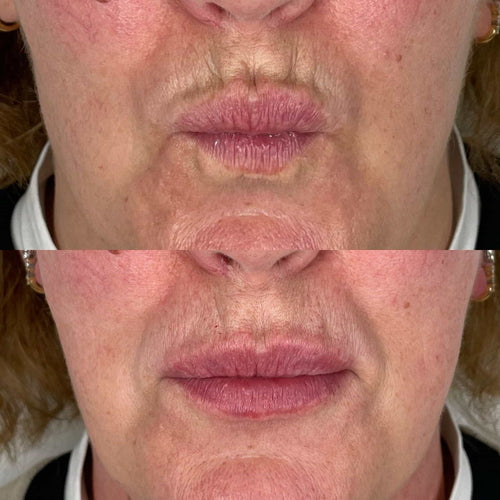Schedule a Dermal Filler Appointment with Dr. Laura Geige Now
Botox’s Impact on Facial Muscles
Muscle Atrophy

Botox, composed of the botulinum toxin type A, temporarily paralyzes muscles by blocking nerve signals that stimulate muscle contractions. When injected into facial muscles responsible for wrinkles, Botox effectively freezes these muscles in a relaxed state.
This paralysis leads to a reduction in dynamic wrinkles – those caused by repetitive facial movements like smiling, frowning, or squinting. Over time, the repeated relaxation of these muscles can lead to changes in muscle structure and function.
Muscle atrophy is the wasting away of muscle tissue due to lack of use. While Botox’s effects are temporary, prolonged and frequent use could potentially contribute to muscle atrophy in facial muscles.
Research on the long-term impact of Botox on facial muscle structure is still ongoing. Some studies suggest that repeated Botox injections might cause a decrease in muscle size and strength over time, particularly in muscles that are frequently targeted.
However, it’s important to note that these changes are often subtle and may not be readily apparent without detailed medical assessment.
Additionally, other factors like genetics, lifestyle, and sun exposure play a significant role in facial aging. Therefore, attributing solely the impact of Botox on muscle atrophy is complex and requires further research.
Temporary vs. Permanent Effects
Botox works by temporarily paralyzing facial muscles. When injected into a muscle, it blocks the nerve signals that cause contraction, leading to relaxation and smoothing of the overlying skin.
This paralysis is temporary, typically lasting 3-6 months. As the Botox wears off, the muscles regain their ability to contract, and the wrinkles gradually return.
While Botox doesn’t directly age you permanently, its repeated use can have subtle effects on facial muscle function over time. Prolonged paralysis of certain muscles may lead to weakening and atrophy (shrinkage).
Some argue that this muscle weakening could contribute to a “frozen” or immobile appearance in the long run. However, the extent to which this occurs is still debated.
It’s important to note that Botox injections should be administered by a qualified and experienced medical professional. Incorrect dosage or placement can lead to complications such as muscle drooping, asymmetry, or spread of the toxin to unintended areas.
Potential Long-Term Consequences
Weakened Facial Expressions
While Botox injections can temporarily smooth wrinkles and reduce the appearance of fine lines, concerns exist about their potential long-term consequences, particularly regarding weakened facial expressions.
Botox works by blocking nerve signals to muscles, causing temporary paralysis. Repeated use can lead to muscle atrophy, meaning the muscles weaken over time due to lack of use.
This muscle atrophy can result in a permanently smoother face, but it can also limit facial expressiveness. Smiling, frowning, squinting, and other subtle facial movements may become less pronounced or even impossible as the muscles responsible for these expressions lose strength.
This potential loss of facial animation could lead to difficulty conveying emotions effectively, potentially affecting social interactions and communication.
Furthermore, the repeated use of Botox can potentially alter the underlying structure of the face. As muscles atrophy, the supporting tissues may also weaken, leading to sagging or changes in facial contours over time.
It is important to note that research on the long-term effects of Botox is ongoing and conclusive evidence regarding its impact on aging and facial expressions remains limited.
However, the potential for weakened facial expressions raises ethical concerns about manipulating natural aging processes and the importance of preserving individual expressiveness.
Dependence and Dosage Concerns
The potential long-term consequences of repeated Botox injections are a subject of ongoing research and debate among medical professionals.
Here’s a breakdown of some key concerns regarding dependence, dosage, and potential aging effects:
Dependence:
- Over time, the muscles treated with Botox can become weaker and less responsive to natural nerve signals. This phenomenon is known as **muscle atrophy**. Some individuals may experience a decrease in muscle tone even when Botox injections are not administered.
- To maintain desired effects, higher dosages of Botox may be required over time. This can lead to an increased risk of side effects and complications.
Dosage Concerns:
- Incorrect dosing can result in **ineffectiveness** or **excessive muscle paralysis**. For example, too little Botox may not adequately reduce wrinkles, while too much can cause drooping eyelids or an unnatural facial expression.
- The amount of Botox required varies depending on individual factors such as age, skin elasticity, and the targeted muscles.
Potential Aging Effects:
- While Botox initially reduces the appearance of wrinkles by paralyzing facial muscles, some experts argue that prolonged use can lead to a **loss of muscle mass and definition**, ultimately contributing to an aged appearance.
- The natural movement and expressions associated with healthy aging may be diminished when muscles are consistently weakened by Botox. This could potentially affect communication and social interactions.
It’s important to consult with a qualified and experienced physician specializing in botulinum toxin injections to discuss the potential risks and benefits, as well as personalized dosage recommendations.
Ongoing research is continually expanding our understanding of the long-term effects of Botox. Individuals considering repeated injections should stay informed about the latest findings and make decisions based on their individual circumstances and health goals.
Expert Opinions and Ongoing Research
Scientific Evidence
The relationship between Botox injections and aging is complex and multifaceted, with ongoing research exploring both potential benefits and drawbacks.
Schedule a Dermal Filler Session with Dr. Laura Geige Now
Expert opinions on whether Botox ultimately ages you are divided.
Some experts argue that by repeatedly paralyzing facial muscles, Botox can weaken them over time, potentially leading to muscle atrophy and a less mobile face. This could contribute to an aged appearance.
However, other experts believe that the benefits of Botox in reducing wrinkles and maintaining a youthful appearance outweigh any potential long-term risks.
They argue that regular Botox treatments can prevent deep wrinkles from forming in the first place, potentially delaying the visible signs of aging.
Scientific evidence regarding the long-term effects of Botox on facial aging is still evolving.
-
Some studies have shown that repeated Botox injections can lead to a reduction in muscle thickness and strength, but these changes are often temporary.
-
Other research suggests that Botox may stimulate collagen production, which could potentially improve skin elasticity and reduce wrinkles.
Longitudinal studies with larger sample sizes are needed to definitively determine the long-term impact of Botox on facial aging.
It is important to note that individual responses to Botox can vary widely, depending on factors such as age, skin type, and muscle anatomy.
Anyone considering Botox injections should consult with a qualified and experienced medical professional to discuss their individual needs and potential risks and benefits.
Alternative Approaches
Expert opinions on whether Botox ultimately ages you are divided. Some dermatologists argue that while Botox temporarily smooths wrinkles, it can weaken facial muscles over time, leading to a “frozen” appearance and potentially accelerating visible aging.
They point to studies suggesting that repeated injections can contribute to muscle atrophy and decreased elasticity, making the skin more susceptible to sagging and drooping. Prolonged paralysis of certain muscles might also disrupt natural expressions, resulting in an unnatural look as the face ages.
Conversely, other experts maintain that Botox’s benefits outweigh its potential drawbacks. They emphasize that preventing wrinkles early on can delay visible signs of aging and allow individuals to maintain a youthful appearance for longer.
Book Your Dermal Filler Consultation with Dr. Laura Geige at It’s Me and You Clinic
They argue that responsible use of Botox, combined with proper skincare and lifestyle choices, can effectively combat wrinkles without causing significant long-term harm. Moreover, advancements in neurotoxins have led to more refined formulations and techniques, minimizing the risk of muscle atrophy and promoting natural-looking results.
Ongoing research continues to explore the long-term effects of Botox. Studies are investigating the impact on facial muscles, skin elasticity, and overall aging process. Researchers are also exploring alternative approaches to wrinkle reduction, such as dermal fillers, laser treatments, and radiofrequency therapy.
These alternatives aim to address wrinkles and sagging in different ways, offering patients a wider range of options for preserving their youthful appearance.
Mind Plus Motion K’s P Rules Cakes Josie Barrett The New Cinema Magazine Azmia Magane
- The Best THC Beverages For A Relaxing Evening At Home - December 6, 2025
- The Benefits Of CBD Gummy Edibles For Overall Wellness - December 3, 2025
- THC Seltzers:A New Trend In Social Drinking - December 2, 2025
